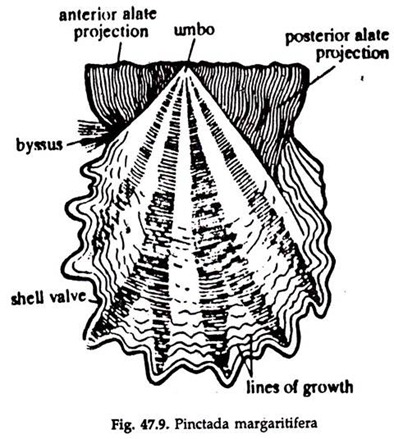In this article we will discuss about:- 1. Meaning of Pearl Culture 2. Important Pearl-Producing Oysters 3. Distribution in Indian Waters 4. Biology of Pearl Oyster 5. Formation of Pearl 6. Artificial Pearl Culture 7. Large-Scale Pearl Culture.
Meaning of Pearl Culture:
Pearl is secreted by the mantle of marine bivalve molluscs, the pearl oysters (Fig.47.9). The Secretion is known as nacre or mother of pearl. It is deposited in extremely thin layers. Collection of oyster from the sea bed, opening the shell (valves) and getting the pearl from them is collectively termed ‘Pearl fishery.’
Important Pearl-Producing Oysters:
a. Pinctada fucata
ADVERTISEMENTS:
b. Pinctada chemnitzi
c. Pinctada margaritifow (Fig.47.9)
d. Pinctada anomioides
c. Pinctada atrapurpurea
ADVERTISEMENTS:
The first one occurs in Indian seas while the others are found in other Oriental seas.
Distribution in Indian Waters:
Two zones in the Indian coast are well- known for pearl oysters.
a. The Gulf of Kutch along the northern coast of Gujarat.
b. The Gulf of Mannar adjoining Tamil Nadu coast.
ADVERTISEMENTS:
c. The beds are vast in the Gulf of Mannar. Oyster beds are present at a depth of 10 to 20 metres and at a distance of 11 to 16 kilometer from the coast.
d. The area of continental shelf is maximum at the eastern coast and these beds yield high-quality pearl.
Biology of Pearl Oyster:
a. The oyster usually breeds several times in succession.
b. The larvae are free-swimming and feed upon microscopic organisms.
c. They undergo metamorphosis and finally settle, known 4s Spat fall, at the bottom, in large numbers.
d. The young oyster has a fast growth rate and attains about 50 mm size in a year.
Formation of Pearl:
a. If a small foreign particle, an inert material, e.g. sand particle, hard object, etc.; living object, e.g. parasite, penetrates the mantle of the oyster, the cells of the mantle get attached to it.
b. The foreign particle forms the nucleus over which more or less concentric layers of mother of pearl is secreted.
c. In case the particle penetrates deep enough, a sac or cyst is first formed around the particle and pearl formation occurs within the sac.
ADVERTISEMENTS:
d. With time, due to more secretion, it enlarges in size and the pearl is formed.
c. The natural pearl is rarely a sphere, as it assumes the shape of the nucleus.
f. the process is very slow and continues for the whole life of an oyster.
g. The value of a natural pearl depends on its size, shape, colour and lusture.
Artificial Pearl Culture:
Japan was the first to develop scientific pearl culture in 1907. Introduction of large particles of desired shape and size made it possible to get pearls of different shapes and sizes.
Large-Scale Pearl Culture:
a. Sandwich type nets made of iron rods are used. A net measures 60 x 40 cm and is partitioned into 5 equal sections. Each section is woven with 2 mm thick nylon twine to get 2 cm2 meshes. The iron frame is heavily painted to prevent rusting.
b. The young oysters collected from their habitat are placed in the nets and firmly secured by a twine running all along the four sides of the frame.
c. The nets are suspended from a wooden raft 6.0 x 4.5 m in suitable area in sea.
d. Planks are fitted to the raft for working space and also for periodical examination of the oysters. Each net accommodates 150 to 250 oysters and each raft holds up to 30 such nets. The raft is fixed to empty wooden barrels or metallic drums.
e. After the attainment of desired size, the oysters are cleaned, taken to laboratory and kept in sea water tanks for conditioning.
f. Healthy oysters are anaesthetized in menthol solution in sea water.
g. The specimen is firmly fixed on a special stand and the two valves of the shell are opened by a pair of tongs.
h. An incision is made in the pallial ridge and a piece of mantle from another oyster is introduced in the incision and implanted in the tissue.
i. The oyster is put back in a basin containing sea water, which is changed for several times a day.
j. After recovery the oysters are transferred to tanks with well-aerated water. After 7 days they are placed in pearl nets in sea water.
k. Deposition of ‘nacre’ starts after a month of implantation and pearl can be obtained within 108-190. days.
The rate of nacre deposit is faster in warm tropical waters. India has knowhow for warm water pearl culture but much more sophistication including modernisation is necessary.
